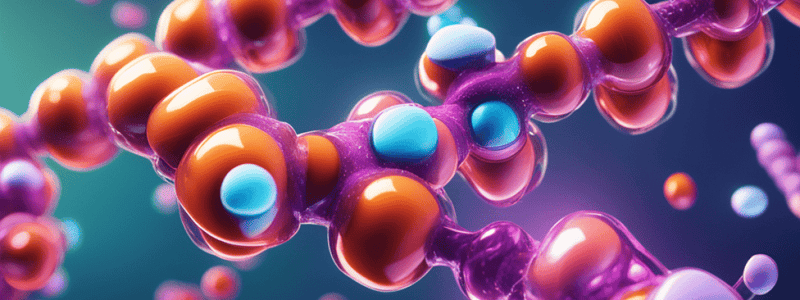Podcast
Questions and Answers
What is the general area of study concerned with the formulation, manufacture, stability, and effectiveness of pharmaceutical dosage forms?
What is the general area of study concerned with the formulation, manufacture, stability, and effectiveness of pharmaceutical dosage forms?
- Pharmacognosy
- Pharmacodynamics
- Biopharmaceutics (correct)
- Pharmacokinetics
What type of substances are intended for use in the diagnosis, cure, mitigation, treatment, or prevention of disease?
What type of substances are intended for use in the diagnosis, cure, mitigation, treatment, or prevention of disease?
- Placebos
- Excipients
- Drugs (correct)
- Adjuvants
Which factor does biopharmaceutics NOT involve?
Which factor does biopharmaceutics NOT involve?
- The design of the drug product
- The route of administration
- The marketing strategy for the drug product (correct)
- Stability of the drug within the drug product
What are drug products considered to be in relation to drug delivery systems?
What are drug products considered to be in relation to drug delivery systems?
What kind of activity may be involved in the delivery of drugs to the site of action?
What kind of activity may be involved in the delivery of drugs to the site of action?
Which factor is NOT part of the considerations related to drug product design?
Which factor is NOT part of the considerations related to drug product design?
Which enzyme is responsible for converting Angiotensin I to Angiotensin II?
Which enzyme is responsible for converting Angiotensin I to Angiotensin II?
Which class of drugs can inhibit the activity of Angiotensin Converting Enzyme (ACE)?
Which class of drugs can inhibit the activity of Angiotensin Converting Enzyme (ACE)?
Which enzyme is inhibited by NSAIDs?
Which enzyme is inhibited by NSAIDs?
What is the primary binding site of allosteric modulators on a receptor?
What is the primary binding site of allosteric modulators on a receptor?
Which transporter is inhibited by Digitalis (Digoxin)?
Which transporter is inhibited by Digitalis (Digoxin)?
Which drug classification can stabilize the inactive receptor site?
Which drug classification can stabilize the inactive receptor site?
What does pharmacodynamics refer to?
What does pharmacodynamics refer to?
What does clinical toxicology study?
What does clinical toxicology study?
What is toxicokinetic concerned with?
What is toxicokinetic concerned with?
What is pharmacokinetics concerned with?
What is pharmacokinetics concerned with?
What are G protein-coupled receptors (GPCRs) involved in?
What are G protein-coupled receptors (GPCRs) involved in?
What does bioavailability refer to?
What does bioavailability refer to?
What is the smallest dose that produces the maximum response known as?
What is the smallest dose that produces the maximum response known as?
Which type of drug-receptor interaction involves a permanent bond?
Which type of drug-receptor interaction involves a permanent bond?
What is the measure of the relative safety of a drug, calculated as TD50/ED50?
What is the measure of the relative safety of a drug, calculated as TD50/ED50?
In which type of transport process does movement occur along an electrochemical gradient?
In which type of transport process does movement occur along an electrochemical gradient?
Which enzyme system is subject to polymorphism and can affect the metabolism of drugs like thioridazine and antidepressants?
Which enzyme system is subject to polymorphism and can affect the metabolism of drugs like thioridazine and antidepressants?
What factor affects absorption by influencing the rate and extent of a drug's entry into the systemic circulation?
What factor affects absorption by influencing the rate and extent of a drug's entry into the systemic circulation?
Which property of carriers involves their recognition of only certain molecular configurations?
Which property of carriers involves their recognition of only certain molecular configurations?
What is the phase of drug metabolism involving oxidation, reduction, and hydrolysis?
What is the phase of drug metabolism involving oxidation, reduction, and hydrolysis?
Which enzyme is responsible for the metabolism of substrates like theophylline, caffeine, and clozapine?
Which enzyme is responsible for the metabolism of substrates like theophylline, caffeine, and clozapine?
What is the primary site of excretion for drugs in the body?
What is the primary site of excretion for drugs in the body?
Which category of drugs are commonly associated with genetic polymorphism affecting the expression of drug-metabolizing enzymes?
Which category of drugs are commonly associated with genetic polymorphism affecting the expression of drug-metabolizing enzymes?
What is the measure of similarity in bioavailability of a generic drug product to that of the innovator or reference drug product?
What is the measure of similarity in bioavailability of a generic drug product to that of the innovator or reference drug product?
Which enzyme is responsible for the acetylation of Isoniazid, Hydralazine, and Procainamide?
Which enzyme is responsible for the acetylation of Isoniazid, Hydralazine, and Procainamide?
Which enzyme inhibitors affect CYP2C19 activity?
Which enzyme inhibitors affect CYP2C19 activity?
What predicts when a steady state level is achieved when drug doses are given at regular intervals?
What predicts when a steady state level is achieved when drug doses are given at regular intervals?
What is the volume of blood that is cleared of the drug per given time?
What is the volume of blood that is cleared of the drug per given time?
Which drugs are used to treat or inhibit the growth of cells considered foreign to the body?
Which drugs are used to treat or inhibit the growth of cells considered foreign to the body?
Which division of the nervous system is responsible for carrying impulses to the organs that are voluntarily moving such as skeletal muscles?
Which division of the nervous system is responsible for carrying impulses to the organs that are voluntarily moving such as skeletal muscles?
What does Pharmacodynamics (PD) study?
What does Pharmacodynamics (PD) study?
'Anatomic Divisions of the Nervous System' falls under which part of pharmacology?
'Anatomic Divisions of the Nervous System' falls under which part of pharmacology?
What is the functional difference between pre-synapse and post-synapse in synaptic neurotransmission?
What is the functional difference between pre-synapse and post-synapse in synaptic neurotransmission?
Study Notes
Pharmaceutical Dosage Forms
- Pharmaceutical dosage forms are concerned with the formulation, manufacture, stability, and effectiveness of pharmaceutical products.
Pharmaceuticals
- Pharmaceuticals are substances intended for use in the diagnosis, cure, mitigation, treatment, or prevention of disease.
Biopharmaceutics
- Biopharmaceutics does not involve the psychological or social effects of drugs.
Drug Delivery Systems
- Drug products are considered to be in relation to drug delivery systems.
Site of Action
- The delivery of drugs to the site of action may involve enzymatic activity.
Drug Product Design
- The consideration of gender is not part of drug product design.
Enzymes
- Angiotensin Converting Enzyme (ACE) is responsible for converting Angiotensin I to Angiotensin II.
- ACE inhibitors are a class of drugs that can inhibit the activity of Angiotensin Converting Enzyme (ACE).
- NSAIDs inhibit the activity of the enzyme cyclooxygenase.
Receptors
- The primary binding site of allosteric modulators on a receptor is the allosteric site.
- Digitalis (Digoxin) inhibits the transporter Na+/K+-ATPase.
- Agonists can stabilize the active receptor site, while inverse agonists can stabilize the inactive receptor site.
Pharmacodynamics
- Pharmacodynamics refers to the study of the effects of drugs on the body.
Clinical Toxicology
- Clinical toxicology studies the adverse effects of drugs on the body.
Toxicokinetics
- Toxicokinetics is concerned with the absorption, distribution, metabolism, and excretion of toxins.
Pharmacokinetics
- Pharmacokinetics is concerned with the absorption, distribution, metabolism, and excretion of drugs.
G Protein-Coupled Receptors (GPCRs)
- G protein-coupled receptors (GPCRs) are involved in signal transduction.
Bioavailability
- Bioavailability refers to the proportion of the administered dose of a drug that reaches the systemic circulation.
Dose-Response
- The smallest dose that produces the maximum response is known as the maximum effect dose.
Drug-Receptor Interaction
- Irreversible antagonism involves a permanent bond between the drug and receptor.
Safety
- The therapeutic index is the measure of the relative safety of a drug, calculated as TD50/ED50.
Transport Processes
- Active transport involves movement along an electrochemical gradient.
Enzyme Polymorphism
- The enzyme system CYP2D6 is subject to polymorphism and can affect the metabolism of drugs like thioridazine and antidepressants.
Absorption
- The rate and extent of a drug's entry into the systemic circulation are affected by factors like blood flow, pH, and surface area.
Carriers
- The property of carriers that involves their recognition of only certain molecular configurations is stereospecificity.
Metabolism
- The phase of drug metabolism involving oxidation, reduction, and hydrolysis is phase I metabolism.
- The enzyme CYP1A2 is responsible for the metabolism of substrates like theophylline, caffeine, and clozapine.
Excretion
- The primary site of excretion for drugs in the body is the kidneys.
Genetic Polymorphism
- The category of drugs commonly associated with genetic polymorphism affecting the expression of drug-metabolizing enzymes is antidepressants.
Bioavailability
- Bioequivalence is the measure of similarity in bioavailability of a generic drug product to that of the innovator or reference drug product.
Enzyme Inhibitors
- The enzyme NAT2 is responsible for the acetylation of Isoniazid, Hydralazine, and Procainamide.
- Omeprazole is an inhibitor of CYP2C19 activity.
Steady State
- The time required to achieve steady-state levels is predicted by the half-life of the drug.
Clearance
- The volume of blood that is cleared of the drug per given time is known as clearance.
Immunopharmacology
- Immunopharmacology involves the use of drugs to treat or inhibit the growth of cells considered foreign to the body.
Nervous System
- The somatic nervous system is responsible for carrying impulses to the organs that are voluntarily moving, such as skeletal muscles.
Pharmacology
- Pharmacodynamics (PD) studies the effects of drugs on the body.
- Anatomic Divisions of the Nervous System falls under the category of pharmacology.
- The functional difference between pre-synapse and post-synapse in synaptic neurotransmission is that pre-synapse is the release of neurotransmitters, while post-synapse is the binding of neurotransmitters to receptors.
Studying That Suits You
Use AI to generate personalized quizzes and flashcards to suit your learning preferences.
Related Documents
Description
Test your knowledge of drug interactions and reversibility of drug-receptor interactions with this quiz. Explore scenarios where one drug's effect is modified by another and assess the type of bond or interaction formed between the drug and receptor.




